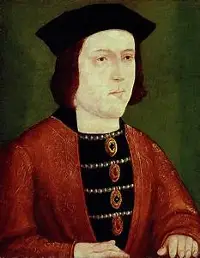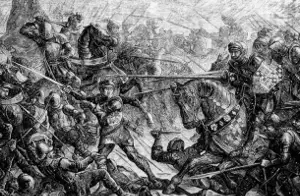King Edward IV of England
Edward IV was a strong, powerful king with a military acumen to match. He ruled for a time during England's 15th Century civil war the Wars of the Roses. 
Edward was born on April 22, 1442, at Rouen, France. His father, Richard Plantagenet, Duke of York, was stationed there during the Hundred Years War. York was a powerful man with many friends and resources. He served as Lord Protector to King Henry VI and was named heir apparent in 1460, during the Wars of the Roses, a struggle for the throne between the Houses of Lancaster and York. An early victory by the Lancastrian faction caused York to flee to Ireland, where he stayed for a time. Young Edward went with his uncle, Richard Neville, to Calais, in France. York soon returned and, at the head of a force, challenged Henry's forces again. The Lancastrian forces were victorious at the Battle of Wakefield in December 1460, and York was slain in defeat. Edward, by this time 18 and a strong and powerful man and soldier, took over his father's mantle. His first notable victory was at Mortimer's Cross in February 1461. Most of the Lancastrian royalty were in attendance at this battle: Queen Margaret and Edward, Prince of Wales were accompanied by Owen and Jasper Tudor, father and son supporters of Henry VI. The Tudors were related to Henry VI and were powerful players in south Wales. Despite all of the 
He was proclaimed King Edward IV not long afterward and solidified his hold on the throne by winning the bloody Battle of Towton on March 29. Both sides had agreed to show no mercy before the battle began, and the Yorkist pursuers lived up to that promise in a particularly savage way. The number killed in total is conservatively estimated at 28,000, with Lancastrians making up about 20,000 of those. It was well and truly a decisive victory for Edward, who returned to London in triumph. On June 28, 1461, he marched at the head of a royal procession and was crowned King of England at Westminster. Henry, meanwhile, fled to Scotland, where he spent the next few years. His wife and son went with him and continued to plot yet another return. Edward's hold on the throne was due mainly to his military victories and to the influence of his uncle, Richard Neville, whose family had substantial holdings and resources throughout the realm. Edward could ill afford to alienate Neville. However, while the latter was in France in 1464 negotiating a marriage between Edward and a daughter or sister-in-law of King Louis XI of France, Edward secretly married Elizabeth Woodville, who had been married to a Lancastrian knight, Sir John Grey of Groby. Neville was stunned, as were many other of Edward's supporters, who wanted the king to marry someone of royal blood. At his new wife's urgings, Edward arranged marriages for many in her family. He also named her father head of the treasury. These and various other actions suggested by the queen and taken by the king served to alienate two of his most powerful supporters, his brother George and Neville. The alienated pair joined forces and took up arms against Edward. The resulting Battle of Edgecote Moor was a stinging defeat for the king and resulted in his capture. A popular rebellion forced the king's release, and Edward tried hard to reconcile with both his brother and with Neville. Neither was interested, and the pair stirred up a rebellion in Lincolnshire. Edward was up to the challenge and put down the rebellion. A defiant Warwick threw in his lot with Margaret, wife of the exiled Henry VI, agreeing to support the Lancastrian's reclamation of the throne. After hearing that Warwick had added his brother John to the anti-York faction, Edward fled to Flanders. 
The Duke of Burgundy was Edward's brother-in-law, having married Edward's sister Margaret in 1468. (That Edward preferred an alliance with Burgundy and not with France, as was the preference of Warwick, was another element of the division between the two once allies.) Edward and Burgundy raised a small force to put at the back of Edward's return to England. Edward avoided capture, returning to the friendly confines of York, where he gathered armed supporters. Marching south, he gained followers and soldiers as he went; among those joining him were his brother George, politically mindedly back in the fold. Edward entered London unopposed and took Henry prisoner. A resurgent Edward and his reinvigorated supporters defeated Warwick's force at the Battle of Barnet, and Warwick was killed in the fray. Edward cemented his hold on the throne by winning the Battle of Tewkesbury. During this battle (or slightly after it, depending on the source), the only son of Henry VI, Edward, Prince of Wales, was killed. Henry himself died a few days later, some sources say at the hands of someone else and other sources say of a broken heart. Now firmly in control, Edward set about solidifying his support across the country. He arranged marriages for his two brothers, George marrying Isabel Neville and Richard marrying Anne Neville; both brides were Warwick's daughters. Flexing his muscles, Edward raised an army and invaded France, landing at Calais in June 1475. The force was nowhere near enough to worry the French king Louis XI, however; and, Edward, seeing that support from his ally the Duke of Burgundy wasn't forthcoming, set about arranging a treaty. Three years later, Edward's brother George again changed sides and set about plotting against his brother the king. Edward discovered evidence of the plot and imprisoned his brother in the Tower, eventually signing off on his execution for treason. Weary from battle and intrigue, Edward began to battle for his health. He struggled in and out of illness and fell ill for the last time in the first half of 1483. He died on April 9 of that year and was buried in St. George's Chapel in Windsor Castle. His 12-year-old son Edward was technically his successor but was never crowned. He and his brother disappeared under mysterious circumstances. The next to be crowned King of England was Edward's surviving brother, Richard. |
|
Social Studies for Kids
copyright 2002–2024
David White



 royal luminaries on the Lancastrian side, it was the Yorkist armed forces who carried the day. Owen Tudor was unsuccessful in escaping and was killed. Also of note in this battle was a prediction by Edward that he had a vision of three suns at dawn and that he interpreted it as meaning that he and his two brothers–George and Richard, both of whom were present at the battle–would emerge victorious. Edward later adopted the "sunne in splendour" as his personal emblem.
royal luminaries on the Lancastrian side, it was the Yorkist armed forces who carried the day. Owen Tudor was unsuccessful in escaping and was killed. Also of note in this battle was a prediction by Edward that he had a vision of three suns at dawn and that he interpreted it as meaning that he and his two brothers–George and Richard, both of whom were present at the battle–would emerge victorious. Edward later adopted the "sunne in splendour" as his personal emblem.
